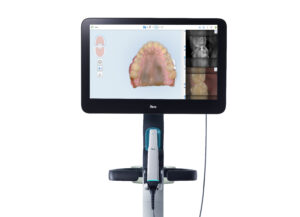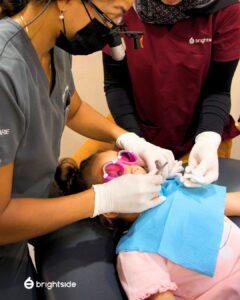A confident smile starts with straight and healthy teeth, but how you get there can look different for everyone. There’s braces, for example, and there’s clear aligners. Understanding how each works can help you feel more in control of your treatment journey, so we’re breaking down the key differences between the two in this article.
//
Traditional Braces

What are traditional braces?
Traditional braces consist of metal or ceramic brackets that are securely bonded to your teeth, connected by wires and elastic bands. These components work together to guide your teeth into their desired positions. Adjustments are made periodically by a dental professional to ensure steady and effective progress throughout the treatment period.
//
Who are they suitable for?
Traditional braces are particularly effective for more complex orthodontic issues. They are commonly recommended for patients with severe misalignment, bite irregularities, or significant spacing concerns. Braces are also used more often in younger patients, such as children and teenagers, due to their reliability and proven results over time.
//
| Advantages | Considerations |
|---|---|
| Highly effective for treating a wide range of conditions, including complex cases that may not be suitable for clear aligners. | Patients may experience some discomfort, particularly after adjustments, as the teeth begin to shift. |
| As braces are fixed onto your teeth, there is no risk of forgetting to wear them, which can help ensure consistent treatment. | Oral hygiene can be more challenging, as brushing and flossing around brackets and wires requires extra care. |
| Braces have been used in orthodontics for decades and remain a trusted and durable solution. | More visible than clear aligners, which may be a consideration for patients seeking a more discreet option. |
//
Clear Aligners

What are clear aligners?
Clear aligners are a modern orthodontic treatment that involves the use of transparent, removable trays designed to move your teeth into alignment. Each set of aligners is custom-fitted based on a digital scan of the your teeth and is worn for approximately one to two weeks before progressing to the next set in the series. When worn consistently, clear aligners can effectively straighten teeth over time with minimal disruption to daily activities.
//
Who are they suitable for?
Typically recommended for individuals with mild to moderate alignment issues, clear aligners are a popular option among adults and teens who prefer a more discreet solution and are committed to following the prescribed wear schedule.
//
| Advantages | Considerations |
|---|---|
| Clear aligners are virtually invisible, making them a discreet option for those who may feel self-conscious about wearing traditional braces. | Aligners must be worn for 20 to 22 hours per day to be effective, which requires a high level of discipline and compliance. |
| They are removable, allowing patients to eat, brush, and floss with greater ease and flexibility. | May not be suitable for treating complex cases that require significant correction or movement. |
| There are no dietary restrictions, as aligners are taken out during meals. | Higher risk of misplacement or damage if aligners are not stored properly when removed. |
//
Which Option is Right for You?
There’s no one-size-fits-all solution when it comes to orthodontic care. Both braces and clear aligners can straighten teeth effectively, but the right choice depends on your dental needs and daily habits. Braces may be more suitable for complex cases, while aligners offer a discreet, removable option for mild to moderate concerns.
At Brightside Dental, we take a patient-first approach with every case. Our dentists provide personalised assessments and transparent explanations so you can make an informed decision.
Feel free to chat with our dentists to explore the best fit for your smile.


